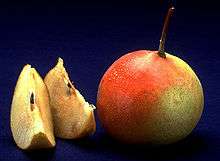Shipova
| Shipova | |
|---|---|
 | |
| Scientific classification | |
| Kingdom: | Plantae |
| (unranked): | Angiosperms |
| (unranked): | Eudicots |
| (unranked): | Rosids |
| Order: | Rosales |
| Family: | Rosaceae |
| Subfamily: | Amygdaloideae[1] |
| Genus: | × Sorbopyrus |
| Species: | × S. auricularis |
| Binomial name | |
| × Sorbopyrus auricularis C.K.Schneid. | |
| Synonyms[2] | |
| |
The Shipova (× Sorbopyrus auricularis) is a hybrid of the European Pear (Pyrus communis) and the Common Whitebeam (Sorbus aria). It is a small to medium-sized tree growing to 10-18 m tall, with deciduous oval leaves 7-11 cm long and 5-6 cm broad. The fruit is a pome 2.5-3 cm long; it is edible with a sweet, yellowish flesh, which tastes similar to a Nashi Pear.
History
The hybrid, known as the Bollwiller Pear, first arose at Bollwiller in Alsace, France, before 1619, and has mostly been propagated by grafting since then; it is nearly sterile, only rarely producing any viable seeds. Two successful seedling propagations have been named as the cultivar 'Bulbiformis' and as the species Pyrus malifolia. However shipova trees are not widely cultivated. Shipova is the only known species in the nothogenus × Sorbopyrus (the hybrid genus of Sorbus and Pyrus)
Similar hybrids
Other intergeneric hybrids within tribe Maleae that include Sorbus as one of the parents are:
- × Amelasorbus
- × Crataegosorbus
- × Malosorbus
- × Sorbaronia
- × Sorbocotoneaster
Alternative genus names
The genus Sorbopyrus (a name published in 1906) has also been known as Bollwilleria Zabel (published 1907), and as Pyraria A.Chev. (published 1925).[3]
References
- ↑ Potter, D.; Eriksson, T.; Evans, R.C.; Oh, S.H.; Smedmark, J.E.E.; Morgan, D.R.; Kerr, M.; Robertson, K.R.; Arsenault, M.P.; Dickinson, T.A.; Campbell, C.S. (2007). Phylogeny and classification of Rosaceae. Plant Systematics and Evolution. 266(1–2): 5–43. [Using the name Spiraeoideae to refer to the subfamily now known as Amygdaloideae]
- ↑ "USDA GRIN Taxonomy".
- ↑ Alfred Rehder (1949). "Bibliography of cultivated trees and shrubs hardy in the cooler temperate regions of the Northern Hemisphere". Arnold Arboretum of Harvard University. p. 260.
- Bean, W. J. (1980). Trees and Shrubs Hardy in the British Isles, eighth edition.